Of course, you will have heard about paracord uses. It has become a must-have item of survival gear for those involved in hiking and camping, as well as among mature survivors. You can use it for fishing, making a hammock, creating a tarp or a tent, use it as a parachute cord, and your dog’s leash. If you are heading to the wilderness, put one of these in your backpack. To learn something that you may not know about tons of use of paracord, read along.
When it comes to survival, we always think of something big like making a shelter, finding a water body to fill in a water bottle, or bringing a first aid kit. But can you name a survival item with multiple uses? One, two, three… I am sure these items have popped into your head: a survival knife, a survival hatchet, survival multi-tool, or duct tape. These are all excellent tools, though, they are not as good as a high-quality survival paracord.
The uses of intact paracord are limited, for sure, but if you separate the strands from each other, then the number of paracord uses simply goes beyond our imagination. Austranats even used 550 cord to repair Hubble Space Telescope!
Well, you may have already guessed correctly: I am going to upend common belief about paracord uses. I have a lot of confidence that paracord can be used in many different ways. And in this article, we will unleash the veil from 35 paracord uses. Learn how to make a rope on your own and use it for your survival needs.
Knots You Have to Know
Sure, as with any other survival items, first you have to know how to deal with them and then put this knowledge into deliberate practice. The same goes with paracord, only here you have to master a few “must-know” knots that will play a major role in a survival situation.
Do not worry. There are only 8 knots that any good prepper should be able to tie under any circumstance:
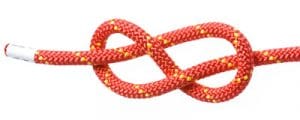
Figure Eight Knots
As the name implies, you have to tie an “eight” in the paracord. Just make a loop over something as a bedrock, wrap the paracord tail under it, and through the first loop. Pull tightly. And here you go: your first “Figure Eight” knot is ready.
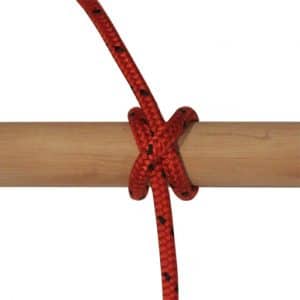
Clove Hitch Knots
You have to tie a paracord around a stick for this knot, then cross the paracord and tie a paracord one more time.
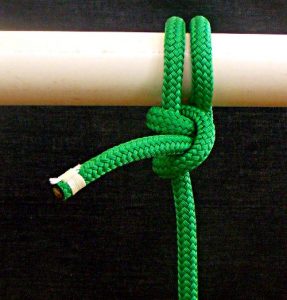
Round Turn Knots
For this knot, you will need a round object you wrap your paracord around twice. Then you cross the cord and repeat the wrapping.
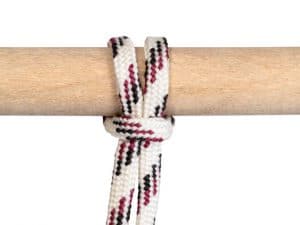
Girth Knots
Put a paracord behind a stick, get it out the stick, and pull through space between the cord and the stick till tight.
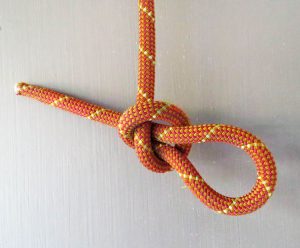
Slipknots
Make two loops. The first one is left untouched, while in the other loop, you insert your paracord at least two times.
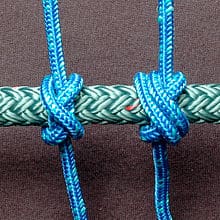
Constrictor Knots
Wrap the paracord around an object from one side and behind, then put a free paracord end through the crossing.
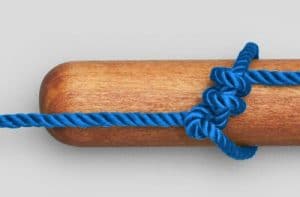
Timber Hitch Knots
Wrap the rope around the object, pass the working end around the standing part, and pull it to the left from below several times. Pull to secure.

Cobra Knots
This one is the most complicated knot since it is braided. Make a loop and tie an overhand knot. Tie a half knot around the loop and tighten. Keeping the same rope in front, tie another half knot and tighten. Repeat till you reach the desired length.
When you have mastered these knots and are ready for the next portion of wired bundles, this site will teach you more about knot tying.
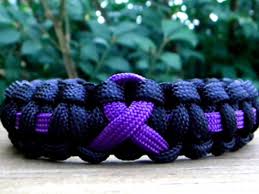
Emergency Paracord Uses
To begin with, we will cover paracord emergency uses since these are vital skills for wilderness survival.
1 – Sutures
There are no guarantees that you will get out of the woods unwounded. Anything can cause a mild or severe trauma, be it simple tripping over a dead branch or an animal attack. Even mild injuries when they are untreated can be fatal, especially if an infection had set in…
Not always you have a professional medical careworker nearby to help you with the injury, especially in a survival situation. Quite often, the wounds require some stitching to avoid serious infections and massive blood loss.
With a reliable suture kit at hand, this task is easy. But what if you did not pack it or lost it on the way? Then a paracord may come in handy, in particular its inner threads. Remember, these sutures are only for emergency use and have to be treated immediately when you reach professional medical care.
Here is the paracord suture guide:
The inner strands of paracord are the best option to stitch a wound in an emergency since they are both strong enough and thick enough.
First, you have to “peel” the outer strands of the paracord so that then you can pull the exposed inner strands out. Try to get a strand as long as possible. Then find yourself a good needle, and you are ready to get the wound closed.
You will start stitching in the middle of the wound. Better if you have a good set of hemostats in your survival medical kit, this way, you will be able to stop the blood flow and see where you have to stitch. Make sure you hold the threaded needle up to maintain sterilization. Push the needle into the skin about half a centimeter from the wound opening.
Every time you push the needle through the skin around the wound, make sure you adjust the hemostats. When you finish each stitch, wrap the thread twice around the hemostat head and pull the thread’s tail through itself to make a knot. The skin edges should not overlap when you pull a thread. Repeat as many times as your wound size requires.
Here’s a short video explanation for the process:
2 – Splint
Quite often, some other traumas, such as muscle, bone, or joint injuries, will await you on the wilderness trip. Not only are such injuries extremely painful, but they might also affect your mobility and, in the worst-case scenario, even leave you fully or partly immobilized or disabled for life.
Such injuries can add some restrains to your rescue mission. Depending on your situation, you might freeze in the cold, get overheated, or lose more fluids than you can take in.
In this case, paracord can come to the rescue and serve as a splint to support a damaged limb and alleviate the pain. And it might enough for you to get through the harsh times and eventually find your way home to safety.
Here’s a short guide of how to make a splint out of a simple cord:
- Cushion the injured limb with something soft like a jacket or shirt.
- Stabilize the injured limb with a stick or something hard.
- Wrap the cord around cushioning and stabilizing material.
- Tie a knot that will not stop blood flow but will also hold the splint.
Chose the knot position appropriate to your injury: joint injuries require the knots above and below the injured joint, while for bone injuries, you have to tie knots on the above and below joints.
If you need extra strength, braid the cord or wrap it several times around a makeshift splint.
3- Sling
A sling is useful for both controlling injured upper limb movements and being a splint in case no real splint is applicable. With a sling, there will be less damage to the injury as well as alleviate the pain.
To make a sling is basically the same as for a splint. You will need a cushioning and hard stabilizing material that you wrap the cord around. For an arm or elbow sling, you will have to tie a slipknot around the wrist, crane it behind the neck and tie it to the elbow with a slipknot. You will also need improvized “cushions” for your neck and elbow to avoid side effects such as irritation and rubbing.
Again, if you need an extra-strength cord, then you can braid it or use several wraps.
In this video, splinting is done with cravats, which is basically the same for paracord:
Cravats are better than paracord, but for survival uses, a paracord might do just as well.
4 – Makeshift Paracord Stretcher
A paracord stretcher is a must-have survival tool when walking is hard due to illness or severely broken limbs.
Never leave a person in need unattended even if you know that help is just right around the corner of the mountain, and it is faster for you to get there and bring the rescue team to the place where you are right now. Why? You might get stuck or injured, while the person might get dehydrated, frozen, or overheated… or an animal might suddenly drop in.
But with a makeshift paracord stretcher, it is possible to move as a group, more slowly but together and moving.
To get a makeshift stretcher, you need ten lengths of paracord. This s-shaped paracord pile is the part for the injured person to lay on. Use an extra piece of cord to make loops using a clove hitch knot on each length and pull the rest of the paracord through these loops. The end must be tied to the stretcher’s body. You can also put poles or human-length sticks through the loops instead of paracord to add stability. Here’s a website that shows the process.
And if you do not have the poles, here’s what the whole assembly will look like:
5 – Tourniquet
Open injuries are always followed by bleeding, either extreme as arterial bleeding that is hard to stop or mild one, but that still can lead to comatose-like conditions. In such cases, a rapid application tourniquet will help, but paracord can do the job just all right.
The only rule for such situations is acting as fast as possible to prevent losing so much blood that consciousness leaves you. If you have a paracord bracelet on your wrist, you already win in speed.
For a paracord tourniquet, you need to braid a 1-1/2 inch wide paracord to avoid lacerations. Do it as quickly as you can. Then wrap the brained paracord above the wound and tie a knot where you put a stick. By turning the stick, you can tighten the tourniquet making the blood flow stop. Untie the stick, so you do not have to hold it permanently with your own hands.
6 – Rescue Line
Thick and long paracord bracelets are a great way of saving time, especially in cases where you do not have a plethora of it, like drowning or quicksand.
To save the victim from trouble, first ensure that you are far enough away from danger. Here works the rule of first providing the oxygen mask to yourself and only then to the baby. Make sure that you stay steady on your two feet. Then tie a figure-eight knot and toss the line directly to the victim or a floating object better upstream so the person can surely grab on the paracord.
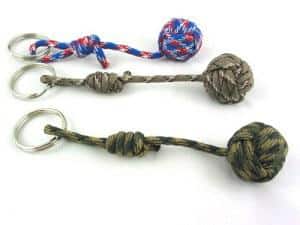
Self Defense Paracord Uses
Survival usually means fighting for yourself and your family. Self-defense is one of the main priorities for any survivalist. Here we provide you with self-defense uses for paracord.
7 – Tripwire Paracord
In the wilderness, animals pose a special threat to your safety. And it is better to be prepared and install some traps at a shin level at a place of most likely intrusion. A tripwire made out of inner strands of paracord may help to disorient an intruder and give you time to hideaway. Just tie the strands between two trees or spikes in the ground. And now you can sleep safely.
8 – Perimeter Tripwire Alarm
Another version of the tripwire discussed above is to locate it at the perimeter of your shelter. I recommend using this option at night or in severe weather since your vulnerability increases at such times.
You can also you Sentry Tactical Trip Wire Alarms with a .22 caliber bullet. When the alarm is tripped, you will hear a loud noise.
Here’s a video for a good tripwire alarm setup:
9 – Restraints
There might come a time when you need to restrain someone by tieing them up to a tree, chair, or any other heave object. During TEOTWAWKI times, anything can happen – everyone is fighting for their lives.
It is best to always have the already braided cord about 1,5 inches thick. You have to make two same sized loops and tread each loop into each other. Insert the intruder’s limbs and tighten.
10 – Firearm Cleaning
Gun barrels can get dirty, especially when exposed to weather elements. That, in turn, affects the accuracy of your shooting by changing a bullet’s trajectory. When your survival depends on your firearm, it is of vital importance to have it work as well as it can. Usually, people use a bore snake for cleaning the firearm.
However, in a survival situation, you can clean the barrel by putting in the paracord with tied knots 1-3 inches apart alongside one-third of the paracord. The knots will get all the dirt away. Remember that you have to apply pressure. If the knots are too easily squeeze into the barrel, you have to retie them and make them bigger.
11 – Sling
No one can ever accurately predict how long they are going to stay in the wild. Everything here depends on your mobility, health, a sense of direction, and natural factors out of your control, such as weather.
And even if you are left with nothing but a survival bracelet, you have quite high chances of getting out of trouble by making an improvised stone-throwing sling. With a sling, you can both defend yourself and your family and catch food.
You do not need much equipment for a sling: just a few 2,5 feet long strips of paracord, some fabric, and a few stones in case your precision is not that good.
The fabric or something similar has to be soaked with a stone inside and let dry for creating a stone pouch. Do not forget to make holes in the fabric for tieing the paracord. On one end of the paracord, tie a bowline knot with a small loop so that your thumb can fit in. This will be the part where you hold the sling. Tie the other end of the paracord to the fabric with three overhand knots. And now, you can begin practicing your precision and accuracy with a makeshift sling!
Here’s a brief video guide on the making of a survival sling:
12 – Monkey Fist Tool
A monkey fist is another simple self-defense tool that you can use paracord to create with. Especially in times of TEOTWAWKI, you will need something to keep your shelter, food supplies, and family safe and sound. A great advantage is that the monkey fist can be used from a distance allowing you to stay away from danger and not being held by another person.
The monkey fist knot has been known and applied in fights since the early 1800s. The evidence shows that with mastering this knot, nothing is a threat.
To make a monkey fist using a paracord, the requirements are simple: a good and lengthy 550 cord, something round to wrap the paracord around, scissors, or a sharp knife.
For defending purposes, choose a big or steel ball and paracord of 4-5 feet long. Loosely wrap the paracord around your spread out fingers and repeat the same four times. Then change directions and repeat four times. Now you have an X with a space inside where you have to slide a stone. Now do the same procedure four times more. The covering should be done with a slow tightening of the cord with four wraps from all angles. Your cord has to be as tight as possible. When there is no room for any applied pressure from your side, stop wrapping and attach the monkey fist to any object.
And as with slings and knots, just keep practicing until you are the master of the trade.
Here’s a video on how to make a monkey fist with a huge ball.
Hunter & Gatherer Paracord Uses
Not only can a paracord help save your life in the sense of self-defense, but also paracord can be used for obtaining and storing food. And as we know it, food is more than just a word – it is essential for keeping you alive under any circumstances, not to mention survival.
13 – Fishing Net
A very old way of getting as many fish as possible is to use a fishing net. And with a paracord at hand, you are destined to provide yourself with enough OMEGA-3.
Cut paracord according to the desired net size and get the inner threads. Attach the sheath that will go horizontally and inner threads that will go vertically to the corners. Inner strands with 2 inches spacing have to be tied to the sheath. When you go in the opposite direction, tie a knot each time strands overlap.
14 – Fishing Line
Sometimes the length of the paracord you have is not enough to make a net, but just enough for a fishing line. Get the inner strands and tie their ends together with a bend knot. Tie the makeshift fishline to the stick, get a hook out of a soda can you might have in your bug out bag, get a load of patience, and… wait for your good luck.
15 – Trotline
Yeah, we all know that fishing requires a ton of patience and a double ton of time, which is of the essence for many survivalists. A single fishing line is not enough to provide you a meal that will stuff you up, but a trotline can do the trick. Repeat the same procedure as for the fishing line but add some additional trots with hooks, and you are ready to adjust the line over two points in a water body.
16 – Fish Stringer
If you are in luck, you can even find the place where fish nest. In this case, you can easily stock up for later. To bring this stuff back to your campsite, you will need a fish stringer. You can use the outer paracord sheath. Just tie one end to a rock, make a slipknot through fish gills and slide it to the rock. Repeat for as many fish as you have.
17 – Bear bag
In the wilderness, you are both a predator and prey. And your hard-earned food is at risk as well. You sure do not want to miss it or give to the mercy of any other wild animal.
With a survival paracord, you can hang your game up and minimize worries of it being picked up by any animal or human thieves.
To make a bear bag, you will have to find a robust branch and a paracord twice as long as the branch. Throw the paracord over the branch, tie your food, and pull it up while tieing the other end of the paracord to the tree trunk or another branch. In this case, it might be wise to braid your paracord for strength.
With a bear bag, you can be sure that no one or nothing is going to steal your food away unless they are good at jumping or climbing trees.
18 – Paracord Animal Trap
Some survivalists also install many animal snares to increase their chances of getting enough food with almost no energy spent. At best, set snares in the late afternoon near water holes or feeding areas, where there are high odds that animals will pass by. Do not worry if you do not catch anything on the first day. Let your trace smell vanish away first.
Make a loop out of paracord with a slipknot, attach it to the hook, which goes to the leader line attached to a tree or stick for tension. Place the bait in the middle of a loop, which is the size of an animal’s neck you wish to catch.
Traveling Paracord Uses
I truly believe that traveling is no different from survival in many ways. And sometimes, moving from one place to another during survival might save your life depending on the situation. So, I would recommend getting yourself acquainted with these traveling paracord uses.
19 – Paracord Snowshoes
Weather is something we cannot control and sometimes even predict for longer than 24 hours (and even that is quite an arguable number!).
Just imagine that you went on a hike in the mountains with no proper footwear, and each step gets harder and harder… Post-holing slows you down and eats away your energy and precious time. But no worries, snowshoes come to the rescue!
There are a few steps to create snowshoes out of parachute cord:
- You will need four branches that are a bit longer than your foot and ten branches wider than your foot.
- Make an outer framework out of 4 long branches enframing your foot.
- Fill in the top, the bottom, and the center parts with five small branches and intersect them with the other five branches.
- Tie the branches with constrictor knots.
- Make the shoe foundation with paracord.
- Make loops on the top to hold your foot or weave the paracord and shoe foundation to your foot.
Now you are more than just ready for a deep snow walking.
20 – Bug-out bag always on you
The End Of The World As We Know It might happen or not, but you have to make sure your bug-out bag is tied to you tightly so no one can take it away from you. When there is a need to survive, essential survival tools are at risk to steal with no ethical requirements.
The whole idea is easy – use basic knots to tie the pack to yourself. No matter what size your bug-out bag is, with a simple knot, you can minimize the probability of theft.
21 – Paracord Trail Markers
Although you may have the best sense of direction in the whole world, you may still get lost while leaving the campsite, even for just a short time. You should also factor in some unpredictable weather changes that may have an impact on your orientation.
Here’s a useful trick that can help you trace your steps back. Short threads of paracord tied at eye-level to branches will show you how back to the campsite or the location you have been before. These threads can later be used as zipper pulls or tinder for fire starting.
22 – Crossing a river
On your many journeys, there will be times when you need to cross a stream as fast and as safely as possible. With nature, odds are never on your side, but with a paracord, you may reach the other side of the water body with little to no worries.
The first method works best in pairs since, in this case, only one person is put at risk while the other is there to help. Tie one end of the paracord with a bowline knot to the first person to cross the stream and tie the other end to the tree. When the person is on their feet on the other side, they should tie the cordage on another tree while you wrap the paracord around yourself.
If the length of the paracord does not allow you to do the crossing one by one, then you should tie the paracord to each other and move slowly together. This method is pretty risky. If one falls, the other might not be able to catch the person, and they can then get swept away.
When crossing the river single-handed, nothing changes except that you have to leave the cord behind. Some streams are way too dangerous to cross without any tool, so it would be a cost well-paid.
23 – Rafting
Well, lucky you, if you just encountered a stream or a river that is narrow enough to cross with a paracord, but what if you have reached a lake or a stream turned into a massive river overnight due to heavy rains? Then using paracord to create a raft may be the best option on the plate.
Look around and find five big wooden logs and four thick long branches to secure the logs together. Place the branches over the logs and use some survival knots to wrap the intersections with a paracord either several times or with a braided cord to add extra strength.
24 – Towing
Let’s imagine: you are out on a motorbike with a beautiful side-carriage packed with everything you need for a picnic when the motorbike suddenly breaks down. Since it is unwise to leave everything behind and you surely need this equipment, the paracord can be used to tow the motorbike to the destination point or the nearest pit stop if there are any on the way. Make sure you braid the paracord and use several knots to affix and strengthen the paracord. A timber hitch is a perfect knot to properly secure the object that needs to be hauled.
25 – Free Hands
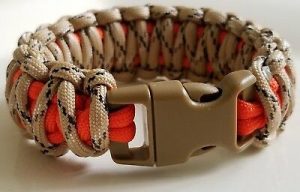
Everyday Survival Paracord Uses
These uses for paracord might not pop into your head right away, for example, survival bracelets, but make sure you know them, so you are prepared for any situation to come.
26 – Shelter Tent Support
Any shelter can be made up of a lightweight tarp and a paracord threaded through the tarp’s eyelets. You can either secure paracord between two trees and put a tarp over it, or you can tie the tarp to get yourself a sleeping hammock.
If you are afraid such construction is going to fail you, just braid the paracord and use two or more lines.
27 – Bow Drill
With the absence of any fire starter kit, an old and rusty bow drilling fire-starting method comes in handy to get the sacred fire to keep you warm and your food ready.
Cut notches in the branch; you are going to use a bow to secure the paracord tied with slip knots. For successful bow-drill performance, you need to secure the paracord as tightly as you can.
28 – Mending Torn Clothes
I can easily imagine a prepper to trip off a tree branch and tearing the pants down. It is not a disaster, you might say. Yeah, but what if the pants are waterproof, and it has been raining the whole time, and no clearance seems to come up any time soon. Here, you may sew the hole with a few paracord stitches from inner strands and enjoy the dryness again.
29 – Belt or Survival Bracelet
In some emergency situations, you might need an emergency belt or a survival bracelet. For this purpose, a cobra knot is extremely useful. Do not forget about the buckle first, though.
I would put these survival bracelets at the five top survival paracord projects. Paracord bracelet is also a survival item that is always on you and can be used as a real, though short, rope in an emergency.
30 – Make A Strong Rope
The rule of thumb for a convenient trip is to make your bag as light as possible. Rope weights quite a lot, while paracord beats it by being lightweight, strong, and less voluminous.
In case you might need a heavy and highly robust rope, just braid a few paracord strands together with cobra stitch or other similar knots. And your climbing rope is ready.
31 – Rope Ladder
Not everyone is born tall. And sometimes, even the tallest of us need some elevation. With an improvised paracord rope ladder, the problem does not exist anymore.
To make the ladder, you will need two long pieces of paracord and a few robust branches capable of holding up your weight when you are going to step on these makeshift rungs. Paracord pieces should lay parallel to each other and overlap the rungs for about 2 inches on both sides. To tie the paracord to the rungs, I recommend using constrictor knots since they are strong enough to endure the pressure and for tieing the top of the ladder, a bowline knot.
32 – Pet Collar / Leash
With a paracord, pet owners might relax if they found out that their pet’s collar or a dog leash had been forgotten or lost somewhere on the way to the destination point.
Be careful when choosing the paracord type to use as a dog leash or collar. It is way safer to use a braided paracord than a single-stranded not to accidentally choke the pet.
33 – Shoelaces
I am more than just sure that at least one time in your life, you had a broken shoelace. Maybe it was near your house so you could go home and change the boot laces. But let’s imagine it is a week-long hiking trip. If you cannot fix it right, the chances of tripping over and an eventual trauma rise significantly.
But lucky you are if you have a paracord at hand! You just have to measure the shoelace length of paracord, melt its end to avoid fraying, and replace the broken shoelace.
I advise you to get paracord fire laces that go with fire starters. This way, you would not have to worry about losing your shoes or your head on your hiking trip.
34 – Hang Tools From Belt
When there is a clear need to survive, quite often, you must have a lot of tools at a hand’s reach. And here, a tool belt comes in as an amazing option to set your hands free and provide you more safety and comfort.
Even for mundane things like food gathering or something more serious as fighting for your life, a paracord belt will help to have all the necessary tools ready.
To get a paracord belt, you need to get a few pieces of paracord about 15 cm in diameter, wrap them around the belt and tie them with a simple but strong knot.
35 – Paracord Dental Floss
This way of using paracord might not be an obvious one as well as the most essential but knowing it may come in handy. I bet all of you have experienced this uneasy feeling of some food stuck between your teeth. And the feeling becomes more and more irritating if you cannot free this piece. No worries, in such situations, you can use inner strands of paracord to experience the relief of getting rid of this nasty piece of food. And it is also a good way of caring about your dental health in the wilderness. Because, well, you know dentists are hard to come by in the woods.
Bottom Line
It does not matter how many videos or articles you read on survival. It is of vital importance that you put every bit of absorbed information into practice, especially if we are talking about paracord uses. Just get yourself a few feet of paracord and start toying around with knots.
FAQ
What is paracord useful for?
Paracord has a number of uses and has to hold a special place in survival gear. I would even recommend getting a paracord bracelet for emergency uses to everyone in your family. You can use paracord for self-defense, like a fishing net, first aid material, or as a support for your shelter’s roof.
Why is paracord so popular?
The popularity of paracord was well established after World War II when it became available not only for the military but also for civilians. 550 cord originally used for suspension lines in parachute is popular due to its weight and many great uses this nylon rope can provide.
Can paracord hold a person?
A 550 paracord is a parachute cord, and for sure, it can hold a person as in a makeshift stretcher, for example. You just have to properly adjust the paracord along the body so the weight is evenly distributed along with the cordage. For adding strength, you can either braid the cord or use several loops.
How long does paracord last?
Since the 550 cord has a nylon sheath, which is highly unlikely to degrade sooner than a few hundred years unless it is exposed to strong chemicals and high temperatures permanently, I would say a paracord is a survival item that would last forever. And with its many uses, paracord is an absolute must-have tool for survival.


